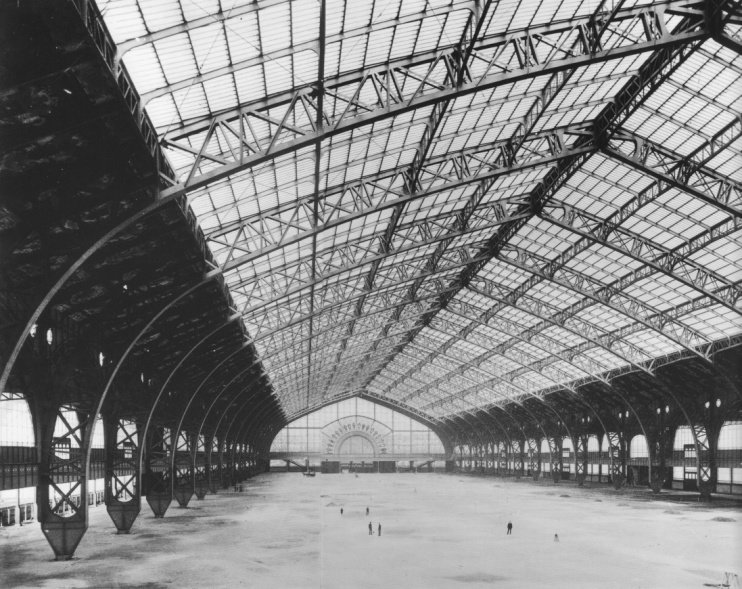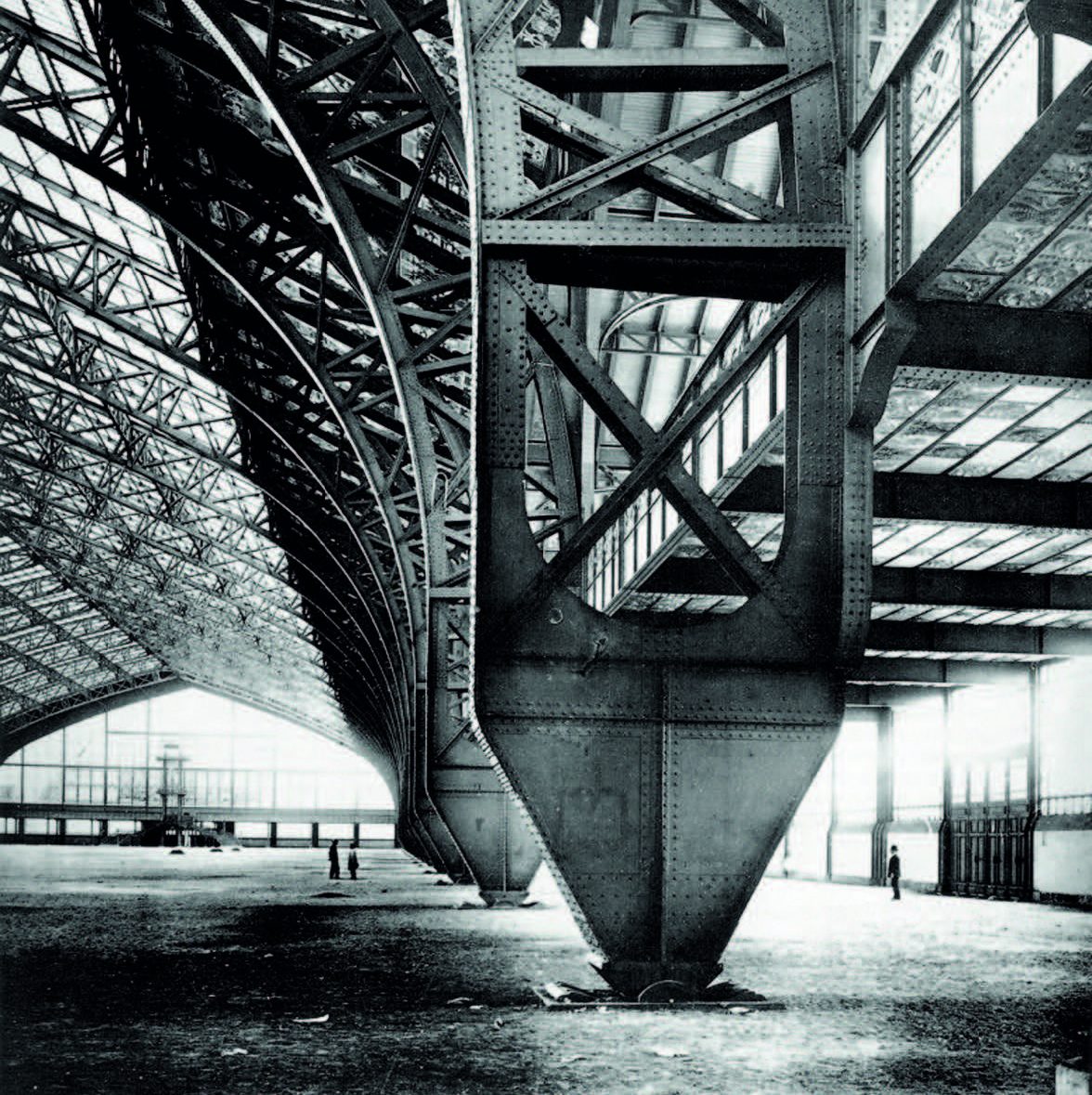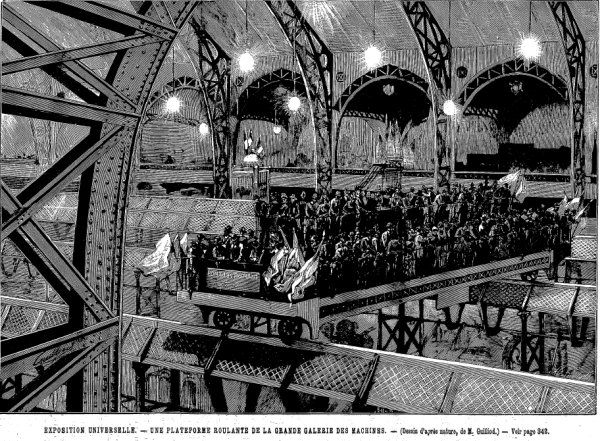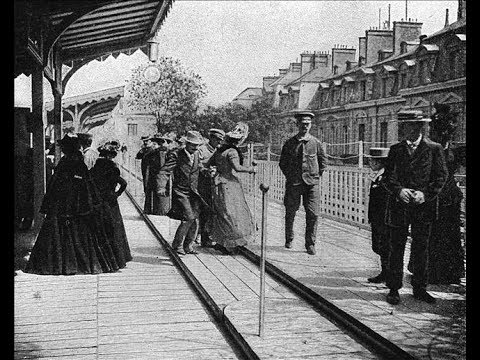“Public opinion had so long ignored the art of iron construction [that people were not prepared to recognize or evaluate a work of the strength and boldness of the Galerie des Mahinces]. I remember very clearly a hallucinatory passage through the brightness of the nave in a travelling crane, above whirlpools of twisting reptilian belts, creaking, whistles, sirens, and black caverns containing circles, pyramids, and cubes.”[1]
Palais des Machines is one of the exhibition galleries designed and constructed for the 1889 Paris World’s Fair and continued to serve for the next World’s Fair in Paris in 1900[2]. The project was conceived during the time of the French Third Republic, by architect Ferdinana Dutert and the structure calculations were prescribed by engineer, Victor Contamin[3]. The whole 1889 World’s Fair was a centennial celebration of the French Revolution, and as well, was an investment in demonstrating France as a centre of progress, recovering from its 1870 defeat in the Franco-Prussian War with provision to claim its national power among its European rivals in the colonial era[4]. To achieve this propaganda agenda and to build the image of a government ready to reform, the architect and engineer of the Palais des Machines had deployed effective spatial and sensorial strategies to induce the human eyes and to create an immersive environment that was made possible by a progressive political power with growing economic strength.
The mission of the Palais des Machines was therefore clear that it needed to accomplish a pedagogical goal to render a venue of seeing and being seen. The voluminous interior was left with an uninterrupted view by a spanning arch structure of 115 metres in a length of 420 metres and a height of approximately 48 metres[5]. Its unprecedented scale was an engineering wonder at the time. The experimental application of iron[6] and glass as well as thoughtful considerations of detailing not only contributed to a physically massive space but also imposed a sublime experience on its visitors. The weight of iron utilized counted up to 7,784,519 kilos[7] which was mostly exposed in the three-hinged iron arches executing the balance of forces and counter forces[8]. With the structural members carefully worked out and materialized, a visible relation of load and support[9] was thus established and conceived by the visitors in the form of the hull of an overturned ship[10] enclosed by a glass membrane. At that point, structure was no longer that of the solid and void, rigid and continuity but rather a presentation of adaptability and integrity of different parts.

Supported by the metal framework, a thin layer of glass wall separated the inside and outside[11]. The rendering of a diaphanous space[12] enhanced the expansion of space by creating a liminal experience. Strictly speaking, the glass wall did not fully circumscribe the space. It is in this union of aesthetics and materiality that the movements of machines inhabited, which also delivered a sense of limitlessness and power. The application of glass was also favored as the material to reinterpret the awe and sacredness of gothic cathedral. Deborah L. Silverman in her article, ‘ The 1889 Exhibition: The Crisis of Bourgeois Individualism’ argued that the layout of the 1889 World’s Fair was in fact subliminally based on the familiar plan of the Christian cathedral with the Eiffel Tower as the spire and the Palais des Machines concluding in the back as a sort of transept[13]. The exhibition hall filled with an enormous amount of industry machineries borrowed another institutional power of cathedral to turn every visitor into a faithful worshiper of a rising colonial power in the European continent. On the other hand, the glass would let penetrate the lights installed in the interior of Palais des Machines[14] at night, adding to the overall perception of ‘the fairyland city’[15] of the fair. It was not just the lights that exceeded the boundaries of spaces, it was also a demonstration of the will and commitment of a nation to exploit electricity as a main game changer in its rank among the world’s most powerful nations.
The structural system of metal framework and glass membrane in the Palais des Machines constructed an unusual proportion of space[16] to the human eyes . It was firstly the discontinuous three-hinged connection of the iron arches that were five times as deep as it was wide (three and a half meters deep by seventy-five centimetres wide) compared to the traditional static perception of the rational proportion of load and support[17]. Contrary to the large arches, the tapered panels landing on the ground was rather modest. This immaterial condition[18] at eye level even released the unimpeded view of the eyes more, exposing the viewers vulnerable to the world of metallic and mechinic beings. When light poured in from above washed down the latticework of iron, the hull of an overturned ship would appear to be floating while the load and support finally became inseparable[19]. Although the disruption of conventional structural order was a challenge to public acceptance, its innovative vision in material applications still stirred a wide public interest. One journalist wrote: “Never before, in the opinion of engineers of all countries who have visited it, has a building, proportionately to its vast dimensions, been constructed with such a wondrous combination of solidity, lightness, and grace, the general effect being enhanced by the flood of light freely admitted to all parts of the palace.”[20]


Eventually, the journey to the Palais des Machines culminated in the tour on the moving cranes (les ponts roulants) above the displays. Powered by electricity, and operated in movement, les ponts roulants travelled along the axis of the gallery[21]. The spectators coming to the Palais des Machines to marvel at the mechinic spectacles would end up finding themselves being registered as part of the movement. The power of electricity was not only able to drive technological progress, it would also be able to inspire human’s progression in space and time. Les ponts roulants remained an appeal in the next World’s Fair in 1900 and was introduced in an urban scale as moving walkways (le trottoir roulant) connecting different exhibition venues in the fair[22]. The attraction of both les ponts roulants and le trottoir roulant touches another colonial vision of human exhibit that were topical in the World’s Fair of late 19th and early 20th century worldwide[23].


The Palais des Machines was a spectacle of structural and material wonder. Succeeded in being ‘a building not bounded by its structural limits’[24], it definitely presented the technological and scientific achievements of the French Third Republic government. More importantly, the success of the building showcased the possibilities of future urban living that inevitably asked for more capital investments and expansion of colonization. These were all mingled in one balanced structural system where each individual component was refined to perfection and to be ultimately entertaining the utmost to the human eyes.
Notes
[1] The sculptor Raymond Duchamp-Villon (1876-1918) wrote of his impressions of Palais des Machines as a thirteen-year-old boy (“L’Architecutre et le fer,” in Poème et Drame (Paris), January – March, 1914). Sigfried Giedion, “Space, Time and Architecture: the Growth of a New Tradition,” in Space, Time and Architecture: the Growth of a New Tradition (Cambridge, MA: Harvard University Press, 2008), 270.
[2] “The Paris International Exhibition of 1900,” Engineering 68 (December 15, 1899): 761. From John W. Stamper, “The Galerie Des Machines of the 1889 Paris World’s Fair,” Technology and Culture 30, no. 2 (April 1989): pp. 330-353, https://doi.org/10.2307/3105107, 350.
[3] Stamper, “The Galerie des Machines”, 334.
[4] Marilyn Wan (1992), 13.
[5] The height as documented in the reference is 48.324 to be precise. “Le Palais Des Machines,” Les Chantiers De L’Exposition Universelle De 1889, April 15, 1887, https://gallica.bnf.fr/ark:/12148/bpt6k5550353r/f5.item, 6.
[6] Stamper, “The Galerie des Machines”, 340 – 41.
[7] Philippe Lemaire, “Exposition Universelle De Paris 1889,” Paris 1889 – Présentation générale – Galerie des Machines, accessed February 14, 2021, https://www.worldfairs.info/expopavillondetails.php?expo_id=6&pavillon_id=500.
[8] Stamper, “The Galerie des Machines”, 339 – 40.
[9] Giedion, “Space”, 266.
[10] Giedion, “Space”, 266.
[11] Giedion, “Space”, 270.
[12] Oscar Linares de la Torre, “Apuntes Sobre El Palais Des Machines De París De 1889: Espacio, Estructura y Ornamento / Notes about the Palais Des Machines of 1889 in Paris: Space, Structure and Ornament,” VLC Arquitectura. Research Journal 5, no. 1 (April 2018): pp. 33-61, https://doi.org/10.4995/vlc.2018.7713, 37.
[13] Michael Adcock, “The 1889 Paris Exposition: Mapping the Colonial Mind,” Context: Journal of Music Research, no. 22 (September 2001): pp. 31-40, https://search.informit.org/doi/10.3316/INFORMIT.199074072135774, 33.
[14] Stamper, “The Galerie des Machines”, 348.
[15] Roger Luckhurst, “Laboratories for Global Space-Time: Science-Fictionality and the World’s Fairs, 1851-1939,” Science Fiction Studies 39, no. 3 (2012): pp. 385-400, https://doi.org/10.5621/sciefictstud.39.3.0385, 393.
[16] Giedion, “Space”, 271.
[17] Giedion, “Space”, 271.
[18] Linares de la Torre, “Apuntes”, 47, and Stamper, “The Galerie des Machines”, 335.
[19] Giedion, “Space”, 273.
[20] Stamper, “The Galerie des Machines”, 341.
[21] Alfred Picard, Exposition Universelle Internationale De 1889 à Paris: Rapport général (Paris: Imprimerie Nationale, 1891), https://play.google.com/books/reader?id=MwY4AQAAMAAJ&hl=en_CA&pg=GBS.PA213, 210 – 13.
[22] Erkki Huhtamo, “(Un)Walking at the Fair: About Mobile Visualities at the Paris Universal Exposition of 1900,” Journal of Visual Culture 12, no. 1 (2013): pp. 61-88, https://doi.org/10.1177/1470412912470523, 67 – 71.
[23] Wan, “ Naturalized Seeing”, Introduction 1-2, and “Human Zoos: A Shocking History of Shame and Exploitation,” CBCnews (CBC/Radio Canada), accessed February 14, 2021, https://www.cbc.ca/natureofthings/features/human-zoos-a-shocking-history-of-shame-and-exploitation.
[24] Giedion, “Space”, 270.
Bibliography
Adcock, Michael. “The 1889 Paris Exposition: Mapping the Colonial Mind.” Context: Journal of Music Research, no. 22 (September 2001): 31–40. https://doi.org/10.3316/INFORMIT.199074072135774.
Durant, Stuart. Palais Des Machines: Paris 1889 ; Ferdinand Dutert. London: Phaidon, 1994.
Giedion, Sigfried. Essay. In Space, Time and Architecture: the Growth of a New Tradition, 270. Cambridge, MA: Harvard University Press, 2008.
Huard, Charles-Lucien. Livre D’or De L’Exposition 1889. Paris: Boulanger, 1889.
Huhtamo, Erkki. “(Un)Walking at the Fair: About Mobile Visualities at the Paris Universal Exposition of 1900.” Journal of Visual Culture 12, no. 1 (2013): 61–88. https://doi.org/10.1177/1470412912470523.
“Human Zoos: A Shocking History of Shame and Exploitation.” CBCnews. CBC/Radio Canada. Accessed February 14, 2021. https://www.cbc.ca/natureofthings/features/human-zoos-a-shocking-history-of-shame-and-exploitation.
“Le Palais Des Machines.” Les Chantiers de l’Exposition Universelle de 1889, April 15, 1887, 6. https://gallica.bnf.fr/ark:/12148/bpt6k5550353r/f5.item.
Lemaire, Philippe. “Exposition Universelle De Paris 1889.” Paris 1889 – Présentation générale – Galerie des Machines. Accessed February 14, 2021. https://www.worldfairs.info/expopavillondetails.php?expo_id=6&pavillon_id=500. copyright L’Exposition Universelle de 1889 – Brincourt – 1889.
Linares de la Torre, Oscar. “Apuntes Sobre El Palais Des Machines De París De 1889: Espacio, Estructura y Ornamento / Notes about the Palais Des Machines of 1889 in Paris: Space, Structure and Ornament.” VLC arquitectura. Research Journal 5, no. 1 (April 2018): 33–61. https://doi.org/10.4995/vlc.2018.7713.
Luckhurst, Roger. “Laboratories for Global Space-Time: Science-Fictionality and the World’s Fairs, 1851-1939.” Science Fiction Studies 39, no. 3 (2012): 385–400. https://doi.org/10.5621/sciefictstud.39.3.0385.
Picard, Alfred. Exposition Universelle Internationale De 1889 à Paris: Rapport général. Google Play. Paris: Imprimerie Nationale, 1891. https://play.google.com/books/reader?id=MwY4AQAAMAAJ&hl=en_CA&pg=GBS.PA213.
Silverman, Debora Leah. “The 1889 Exhibition: The Crisis of Bourgeois Individualism.” Opposition 8, 1970, 70–91.
Stamper, John W. “The Galerie Des Machines of the 1889 Paris World’s Fair.” Technology and Culture 30, no. 2 (April 1989): 330–53. https://doi.org/10.2307/3105107.
Vue Prise d’Une Plate-Forme Mobile, III. Catalogue Lumière , 1900. https://catalogue-lumiere.com/plate-forme-mobile-iii/.
Wan, Marilyn. “Naturalized Seeing/Colonial Vision: Interrogating the Display of Races in Late Nineteenth Century France,” 1992.
Images
Cover Image. Interior of the Palais des Machines with elevator giving access to the second floor and les ponts roulants. Accessed February 14, 2021. https://www.atlasofplaces.com/architecture/galerie-des-machines/.
Figure 1. Palais Des Machines. Dutert and Contamin. World Expo 1889 Paris. ResearchGate. Paris, France: Bureau International des Expositions (BIE). Accessed February 14, 2021. https://www.bie-paris.org/site/en/focus/entry/world-expos-and-architectonic-structures-an-intimate-relationship.
Figure 2. Urban Layout of 1889 World’ Fair Paris. Accessed February 14, 2021. https://www.atlasofplaces.com/architecture/galerie-des-machines/.
Figure 3. Stamper, John W. “The Galerie Des Machines of the 1889 Paris World’s Fair.” Structural Iron and Steel, 1850–1900, 2000, 261–84. https://doi.org/10.4324/9781315242217-11, 263.
Figure 4. de Neuville, Alphonse. Le Pont Roulant De La Galerie Des Machines – Exposition Universelle De 1889. Accessed February 14, 2021. http://www.marc-andre-dubout.org/cf/lvdc/lvdc0266/carnet1.htm.
Figure 5. Vue Prise d’Une Plate-Forme Mobile, III. Catalogue Lumière, 1900. https://catalogue-lumiere.com/plate-forme-mobile-iii/.
